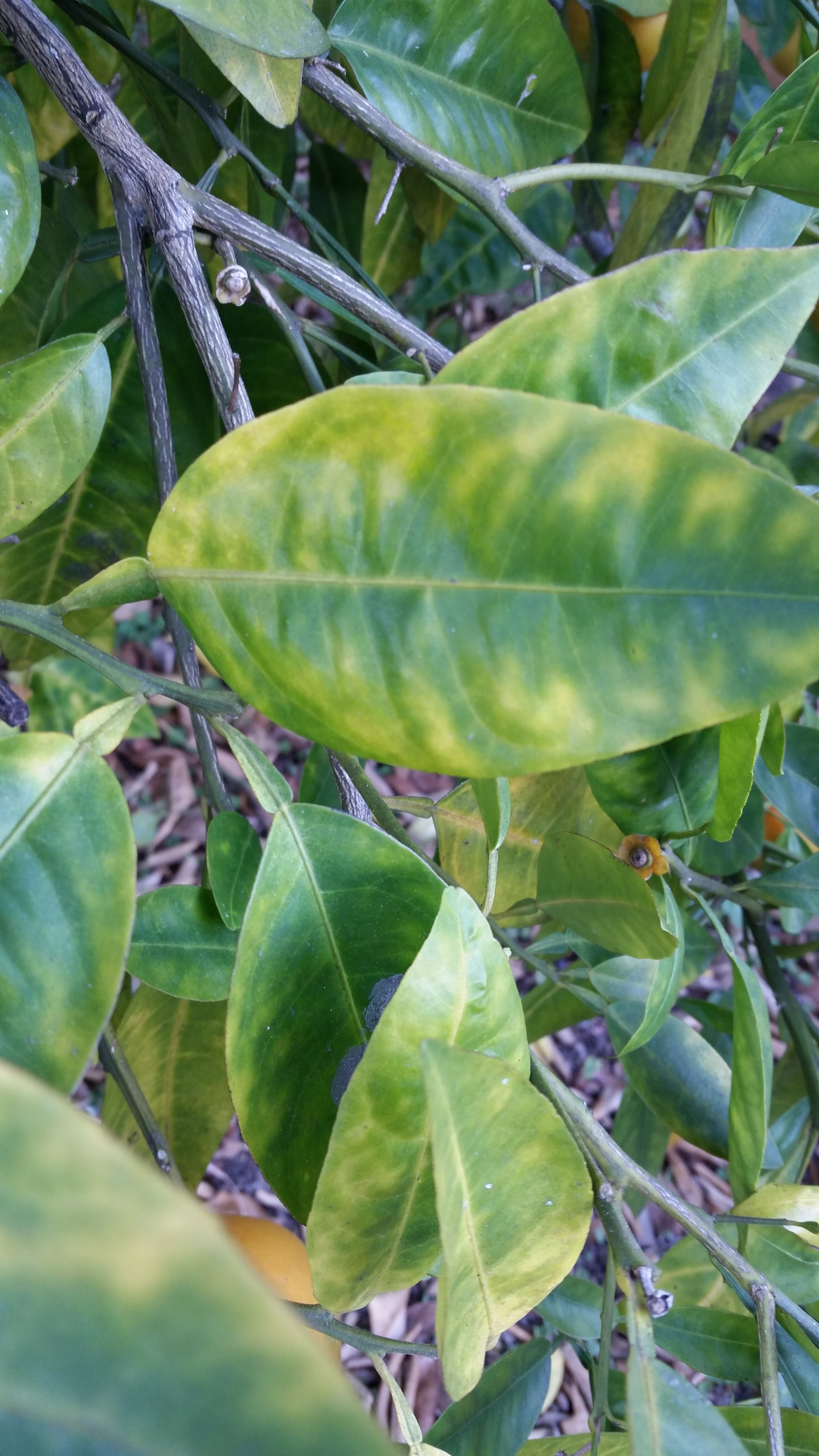
by Carrie Stevenson | Mar 2, 2017
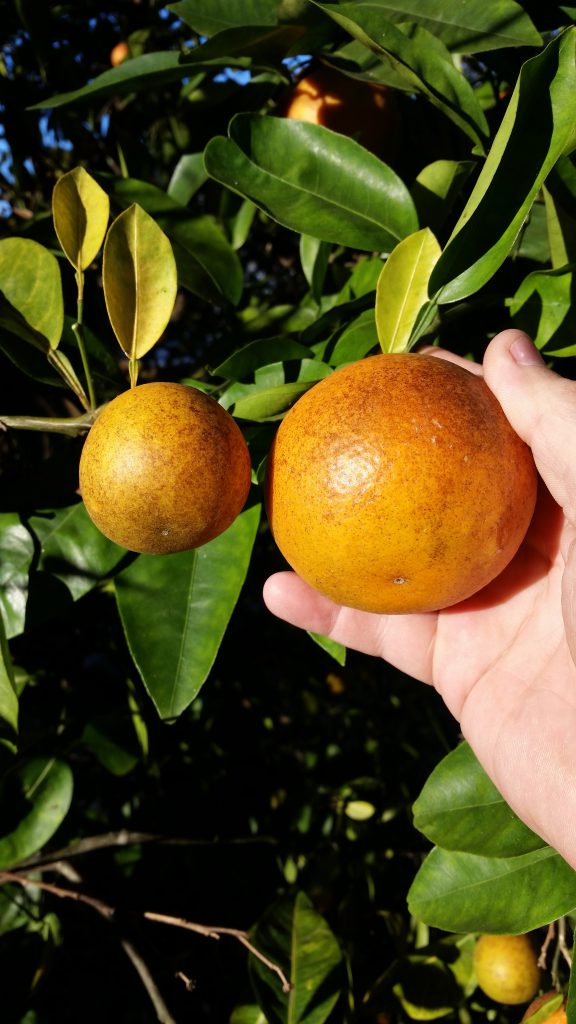
Small Fruit vs Normal
If we look at the big picture when it comes to invasive species, some of the smallest organisms on the planet should pop right into focus. A microscopic bacterium named Candidatus Liberibacter asiaticus, the cause of Citrus Greening (HLB), has devastated the citrus industry worldwide. This tiny creature lives and multiplies within the phloem tissue of susceptible plants. From the leaves to the roots, damage is caused by an interruption in the flow of food produced through photosynthesis. Infected trees show a significant reduction in root mass even before the canopy thins dramatically. The leaves eventually exhibit a blotchy, yellow mottle that usually looks different from the more symmetrical chlorotic pattern caused by soil nutrient deficiencies.
One of the primary vectors for the spread of HLB is an insect called the Asian citrus psyllid. These insects feed by sucking juices from the plant tissues and can then transfer bacteria from one tree to another. HLB has been spread through the use of infected bud wood during grafting operations also. One of the challenges with battling this invasive bacterium is that plants don’t generally show noticeable symptoms for perhaps 3 years or even longer. As you would guess, if the psyllids are present they will be spreading the disease during this time. Strategies to combat the impacts of this industry-crippling disease have involved spraying to reduce the psyllid population, actual tree removal and replacement with healthy trees, and cooperative efforts between growers in citrus producing areas. You can imagine that if you were trying to manage this issue and your neighbor grower was not, long-term effectiveness of your efforts would be much diminished. Production costs to fight citrus greening in Florida have increased by 107% over the past 10 years and 20% of the citrus producing land in the state has been abandoned for citrus.
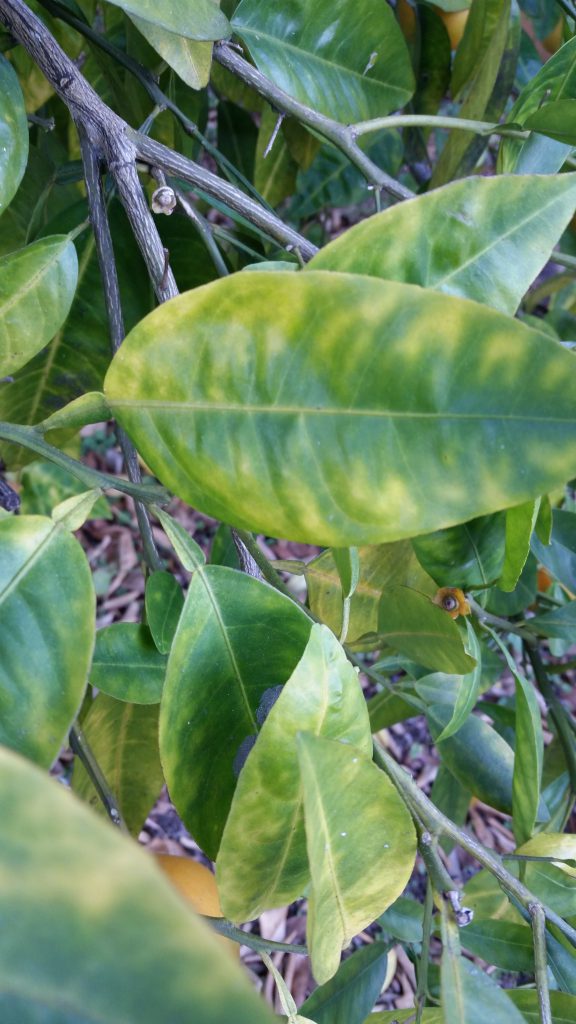
Classic blotchy mottle in Leaves
Many scientists and citrus lovers had hopes at one time that the Florida Panhandle would be protected by our cooler climate, but HLB has now been confirmed in more than one location in backyard trees in Franklin County. The presence of an established population of psyllids has yet to be determined, as there is a possibility infected trees were brought in.
A team of plant pathologists, entomologists, and horticulturists at the University of Florida’s centers in Quincy and Lake Alfred and extension agents in the panhandle are now considering this new finding of HLB to help devise the most effective management strategies to combat this tiny invader in North Florida. With no silver-bullet-cure in sight, cooperative efforts by those affected are the best management practice for all concerned. Vigilance is also important. If you want to learn more about HLB and other invasive species contact your local UF/IFAS Extension office.
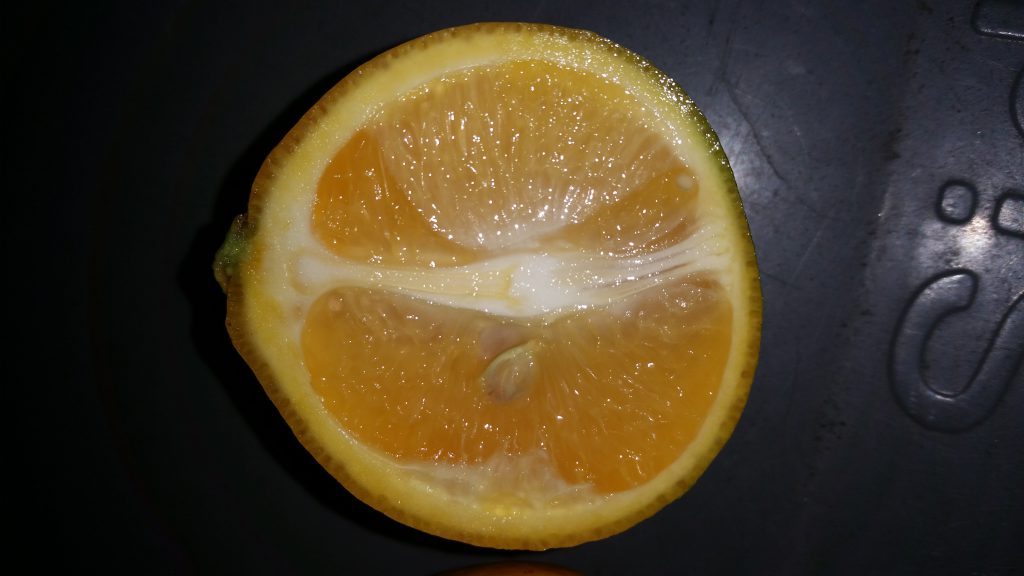
Asymmetrical Fruit
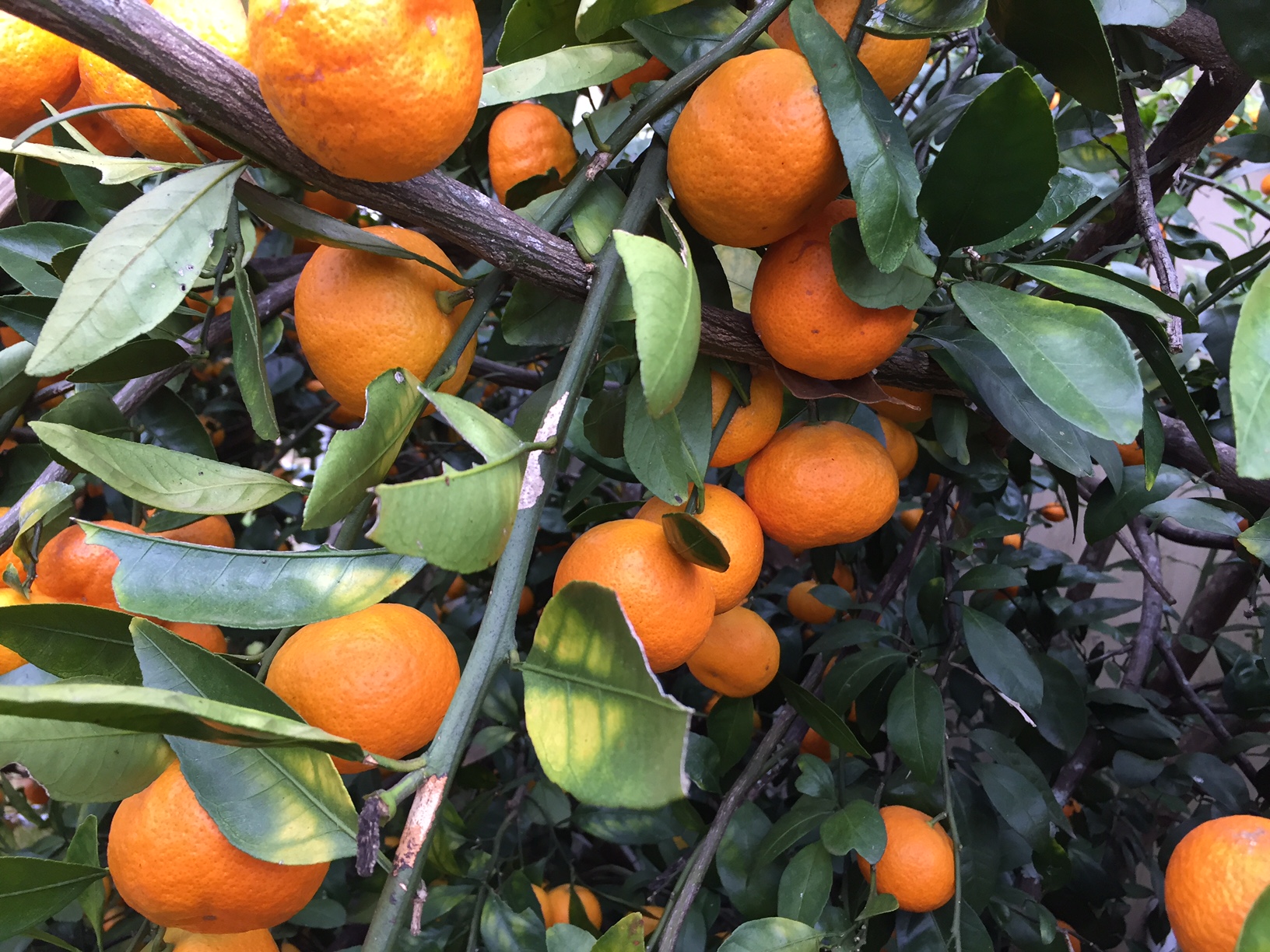
Typical nutrient deficiencies observed in leaf, on trees with heavy fruit load. Not related to Citrus Greening (HLB)
Article by: Erik Lovestrand, UF/IFAS Franklin County Extension Director/Florida Sea Grant Agent
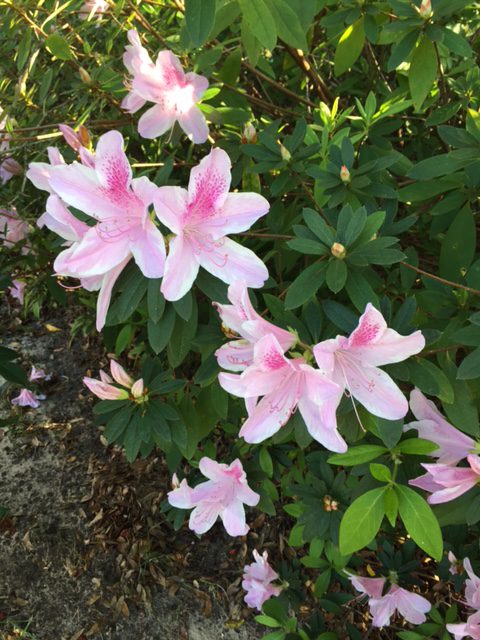
by Carrie Stevenson | Feb 23, 2017
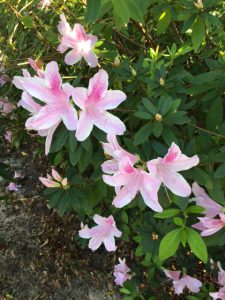
Azaleas have been in full bloom this year since mid-February. Photo credit: Carrie Stevenson
It’s mid-February, and regardless of the groundhog’s prediction, spring seems to have arrived in northwest Florida. In my neighborhood, all the azaleas have bloomed. While beautiful, it’s something that usually doesn’t happen around here until well into March!
According to NOAA and NASA climate data, 2016 was the hottest year globally on record, followed by the previous hottest years, 2015 and 2014. In fact, 16 of the 17 warmest years documented (since official record keeping began in 1880) have been since 2001. The United States also experienced a record-setting year of natural disasters in 2016, ranging from floods to droughts and wildfires.
As the warming trend continues, gardeners, farmers, and wildlife managers alike will find it necessary to adjust their long-held practices. When plants bloom or put on fruit early, these changes can have real economic and commercial impacts. Farmers compete on a global scale to get products to market, and if northern climates start experiencing warmer temperatures, Florida farmers could lose their competitive edge.
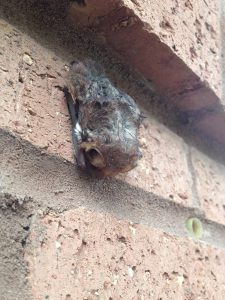
Juvenile bats are vulnerable and therefore protected by state laws during late spring through summer in Florida. Photo credit: Carrie Stevenson
In natural systems, a change in migration or hatching could affect the success of a protected species’ survival. The time frames for these life stages are often legally protected by state or federal laws. For example, in Florida, bats cannot be “excluded” from a building between the April 16-August 14 due to the maternity season. Beach re-nourishment projects are restricted and heavily monitored during sea turtle nesting from May-October. If these time frames start skewing earlier in the year due to changing temperatures and early onset of spring and summer, laws or common practices might need to be evaluated and changed.
In response to these changes in weather patterns, the interesting science of phenology (not to be confused with the brain-mapping “science” of phrenology) has regained popularity in recent years. Phenology is the study of when annual events in the natural world begin—the first hatching of shorebirds, the blooming of spring flowers, the migration of butterflies. For many years, both amateur and professional naturalists have kept records of these phenomena, observing them for pure scientific interest. Now, phenology research has become real-time documentation of a changing world. There are several national networks of citizen scientists making observations and recording them online, including Project Budburst, FrogWatch USA, and the National Phenology Network. If you enjoy spending time outdoors, consider joining one of the many phenology networks and contributing to the larger body of scientific observation. The more we understand about climate-related changes, the better we can prepare and adapt.
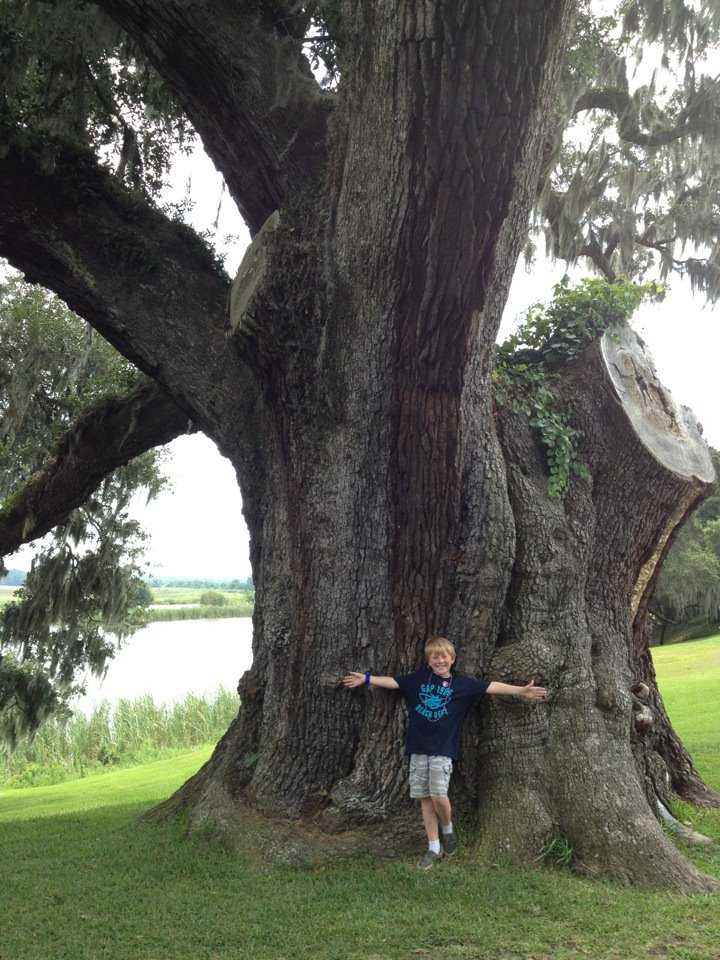
by Carrie Stevenson | Jan 17, 2017
Arbor Day has a 145-year history, started in Nebraska by a nature-loving newspaper editor named J. Sterling Morton who recognized the many valuable services trees provide. The first Arbor Day was such a big success that Mr. Morton’s idea quickly spread nationwide–particularly with children planting trees on school grounds and caring for them throughout the year. Now, Arbor Day is celebrated around the world in more than 30 countries, including every continent but Antarctica. We humans often form emotional attachments to trees, planting them at the beginning of a marriage, birth of a child, or death of a loved one. Trees have tremendous symbolic value within cultures and religions worldwide, so it only makes sense that people around the world have embraced the idea of celebrating a holiday focused solely on trees.

Ancient trees like this live oak have an important place in our cultural history. Photo credit: Carrie Stevenson
In addition to their aesthetic beauty and valuable shade in the hot summers, trees provide countless benefits: wood and paper products, nut and fruit production, wildlife habitat, stormwater uptake, soil stabilization, carbon dioxide intake, and oxygen production. New research is even showing that trees can communicate throughout a forest, sharing “information” and nutrients through a deeply connected network of roots and fungi that can increase the resiliency of an entire forest population. And if you’re curious of the actual dollar value of a single tree, the handy online calculator at TreeBenefits.com can give you an approximate lifetime value of a one growing in your own backyard.
While national Arbor Day is held the last Friday in April, Arbor Day in Florida is always the third Friday of January. Due to our geographical location further south than most of the country, our primary planting season is during our relatively mild winters. Trees have the opportunity during cooler months to establish roots without the high demands of the warm growing season in spring and summer.
To commemorate Arbor Day, many local communities will host tree giveaways, plantings, and public ceremonies. In the western Panhandle, the Florida Forest Service, UF/IFAS Extension, and local municipalities have partnered for several events, listed here. As the Chinese proverb goes, “The best time to plant a tree was twenty years ago. The second best time is now.”
For more information on local Arbor Day events and tree giveaways in your area, contact your local Extension Office or County Forester!
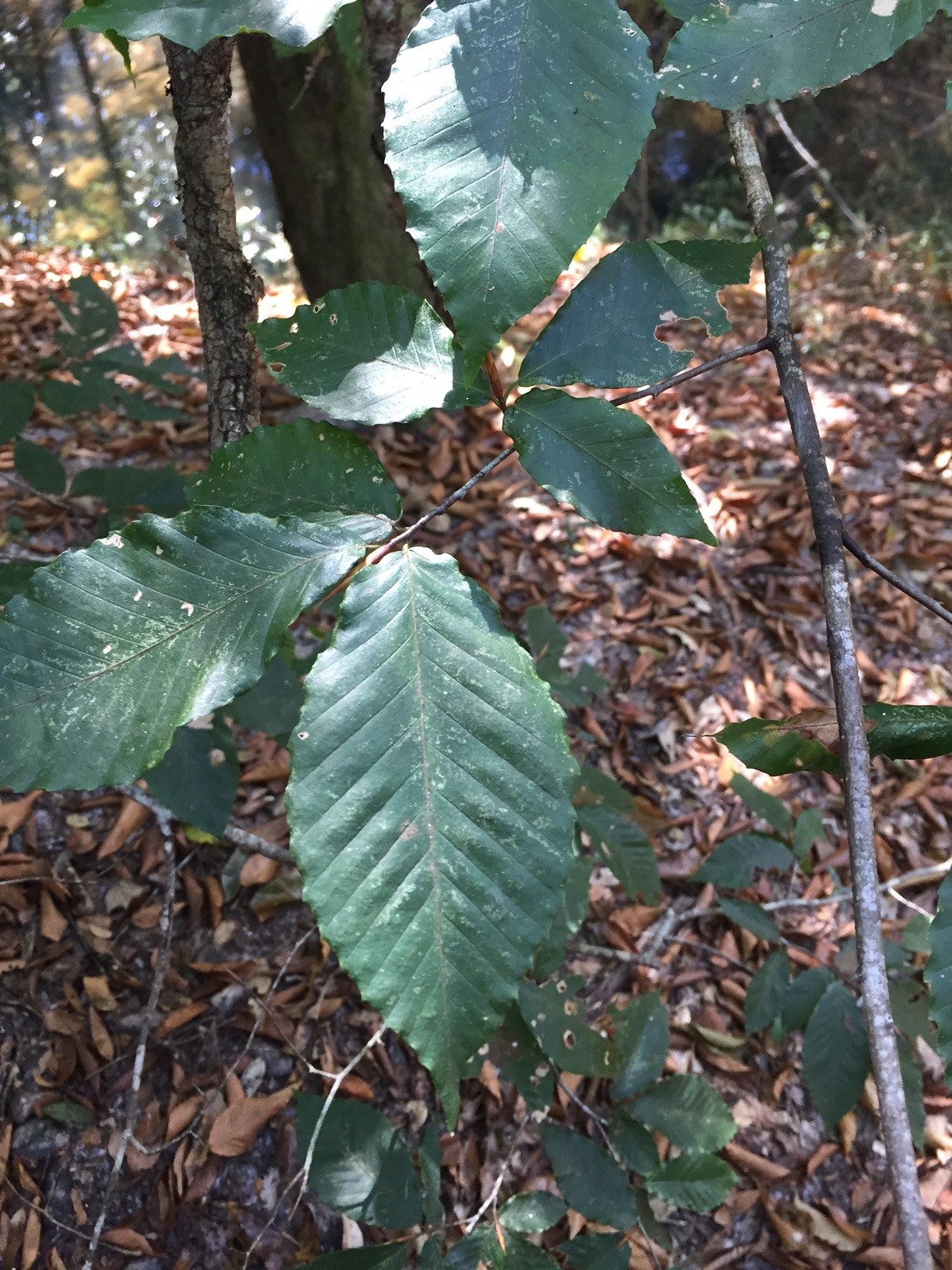
by Carrie Stevenson | Nov 22, 2016
During a recent hike through wooded property in Walton County, our Florida Master Naturalist class came across a stunning example of an American Beech tree (Fagus grandifolia). As we looked closely at its thick, sinewy trunk (often compared to an elephant’s skin), the bark changed hues from a deep red to silvery gray and brown. A hardwood, it has been used over the years to make furniture, railroad ties, and beer barrels. Like many of the local hardwood species, beech wood holds up to decay when exposed to water and early settlers used it to build mills and water wheels.
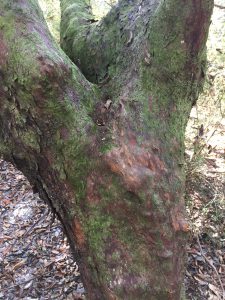
The colorful, smooth bark of a beech tree is eye-catching and strong. Photo credit: Carrie Stevenson
During the growing season, the beech tree can be identified by its distinctive dark green, tooth-edged leaves. Beeches are deciduous but have the unique quality of usually keeping dead leaves on their branches all winter, which also helps with identification in the forest.
The most fascinating observation, to me, was the series of tightly swirled branch buds ready to sprout at the tips of each new branch. So pointed that they’re easily confused as thorns, these long protrusions will eventually grow into new branches.

These four buds formed as an “emergency” response to the branch being cut and will eventually replace it. Photo credit: Carrie Stevenson
At the end of one branch that had been cut, the tree’s internal “emergency response” system formed four new immature branches, which had the intimidating appearance of a claw. Eventually, one of these buds will outcompete the others and grow into a new branch.
Beeches are of course known for the beech nut, eaten by humans and wildlife alike. If you’re considering a beech for a home landscape, be sure you have a wide open space with moist soil, as a mature beech can grow up to 75 feet high and 40-60 feet wide. Its low branches create a lot of shade, so understory plants are usually unnecessary or even impossible to grow.
For more information on these interesting native trees and others like it, contact your local UF IFAS Extension Office or visit the UF Landscape Horticulture page.
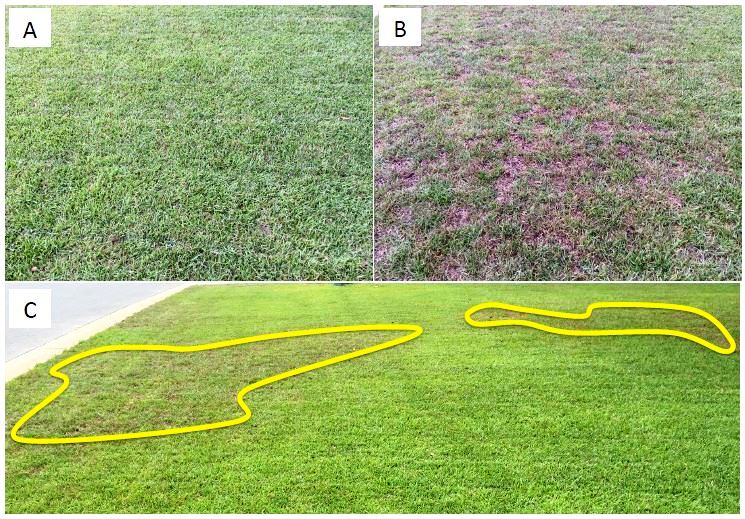
by Carrie Stevenson | Oct 12, 2016
Dr. Ramon Leon, Extension Weed Specialist, West Florida Research and Education Center
Herbicides simplify weed management by allowing you to cover extensive areas in a relatively short time, and reduce the need for time-consuming control practices such as hand weeding. Additionally, many herbicides have the advantage of selective control. Selective herbicides are those that kill weeds without significantly injuring the desired plant. In turfgrass, selective herbicides are particularly important because we do not have the option of using cultivation or non-selective herbicides, as is commonly done in other agricultural systems such as row crops and orchards.
A common misconception is that when a herbicide is registered for use on a given turfgrass species, this herbicide has little negative effect on the turf. In reality, even when the herbicide is registered for a specific turfgrass species, it can cause a certain level of injury. If the herbicide is applied at the recommended label rate, and the growing conditions are ideal, the turfgrass will only suffer minor, temporary injury that may go completely unnoticed. Conversely, the weeds that are susceptible to the herbicide will be severely affected resulting in the desired control.
Over the last few summers, there has been an increase in complaints about herbicide injury on sod farms, golf courses, and home lawns after applications of herbicides, especially during the summer months. Many of those complaints originated from situations in which the application was done properly, using the recommended label rate, and thus the level of injury observed was not justified. After studying all these cases, it was determined that at the time of herbicide application the turf was under a moderate level of stress, but not high enough stress to cause visible symptoms. However, when the herbicide was applied the combined effect of the existing stress, and the stress caused by the herbicide made it harder for the turf to maintain the desired quality. For example, Figure 1 below shows that the turf looked fine before the application (A), but after the herbicide was applied, there was a significant loss in turf cover and quality (B). The interesting aspect is that the injury was not present across the entire treated area, but only on patches (C). Those patches corresponded with sand pockets where soil moisture, especially on hot days, was considerably lower than the rest of the area. In that particular case, the irrigation system was providing enough water to help the turf tolerate the moderate stress of high temperatures and limited moisture, but not enough for the turf tolerate the combined stress that occurred after the herbicide was applied.

Figure 1. Centipedegrass growing during the summer in Florida before herbicide application (A), 3 weeks after herbicide (sulfentrazone and metsulfuron-methyl) application (B). Herbicide injury pattern with highlighted areas showing where sand pockets caused drought and heat stress that contributed to herbicide injury (C).
In Florida, there are a combination of environmental factors such as high temperatures and sandy soils that can create stressful conditions limiting turfgrass growth, especially when irrigation is not sufficient to keep the turf hydrated. Furthermore, we also experience periods of excess rainfall, and areas of turf growing under shade. Additionally, pest problems that affect roots and leaves are frequently found in our state. All these conditions affect turfgrass health and its ability to tolerate herbicide applications. For these reasons, turf producers and managers need to be proactive to help turfgrass overcome the injury that herbicides might cause. To achieve this goal, you need to follow five simple steps:
1) Identify weed problems early. Most weed problems will start in the spring for summer weeds and in the fall for winter weeds. Controlling them when they are small not only increases the effectiveness of our applications, but also allows us to implement our control when the turfgrass is less likely to be stressed.
If herbicide applications are needed when conditions might be stressful for the turf (high temperatures and/or dry conditions)
2) Make sure irrigation is adequate (increase frequency or duration if needed) for up to three weeks following application.
3) Reduce mowing frequency and increase mowing height 0.5 inches for up to 3 weeks following a herbicide application, to allow the turfgrass to continue producing energy to support its recovery. Mowing too short and too frequently immediately after the application weakens the turfgrass.
4) Fertilize with a small amount of nitrogen (0.25 to 0.5 lb N/acre) a week or two after herbicide application to help the turf recover and produce new leaves.
5) If the turfgrass is suffering from serious pest problems (pathogens, nematodes or insect infestations) do not apply herbicides on the affected areas until the turfgrass has recovered.
Maintaining optimal turfgrass growth is the best way to ensure that herbicide applications will maximize weed control while still protecting the health and aesthetics of your turfgrass.
For more information on growing turfgrass in Florida, please see the following:
Dr. Ramon Leon, Extension Weed Specialist, West Florida Research and Education Center














